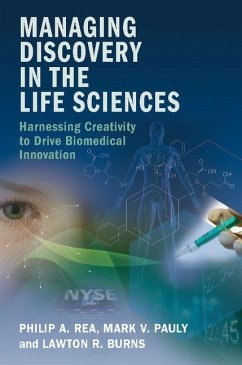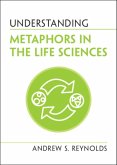Philip A. Rea (University of Pennsylvania), Mark V. Pauly (University of Pennsylvania), Lawton Robert Burns (University of Pennsylvania)
Managing Discovery in the Life Sciences
Philip A. Rea (University of Pennsylvania), Mark V. Pauly (University of Pennsylvania), Lawton Robert Burns (University of Pennsylvania)
Managing Discovery in the Life Sciences
- Broschiertes Buch
- Merkliste
- Auf die Merkliste
- Bewerten Bewerten
- Teilen
- Produkt teilen
- Produkterinnerung
- Produkterinnerung
Key to biomedical innovation is scientific discovery and its translation into marketable products. This book addresses the link between life sciences discoveries and their dependence on the investor-driven market system through in-depth considerations of the challenges that both scientists and managers must face in the pharmaceutical and medical device industries.
Andere Kunden interessierten sich auch für
![The Political Economy of Education The Political Economy of Education]() Martin CarnoyThe Political Economy of Education45,99 €
Martin CarnoyThe Political Economy of Education45,99 €![Understanding Metaphors in the Life Sciences Understanding Metaphors in the Life Sciences]() Andrew S. ReynoldsUnderstanding Metaphors in the Life Sciences21,99 €
Andrew S. ReynoldsUnderstanding Metaphors in the Life Sciences21,99 €![The State and Capitalism in China The State and Capitalism in China]() Margaret M. Pearson (College Park University of Maryland)The State and Capitalism in China30,99 €
Margaret M. Pearson (College Park University of Maryland)The State and Capitalism in China30,99 €![The Politics of Order in Informal Markets The Politics of Order in Informal Markets]() Shelby Grossman (California Stanford University)The Politics of Order in Informal Markets118,99 €
Shelby Grossman (California Stanford University)The Politics of Order in Informal Markets118,99 €![The Care Dividend The Care Dividend]() The Care Dividend44,99 €
The Care Dividend44,99 €![The Marginal Cost of Public Funds The Marginal Cost of Public Funds]() Per-Olov Johansson (Stockholm School of Economics)The Marginal Cost of Public Funds22,99 €
Per-Olov Johansson (Stockholm School of Economics)The Marginal Cost of Public Funds22,99 €![The Economics and Regulation of Network Industries The Economics and Regulation of Network Industries]() Ingo Vogelsang (Boston University)The Economics and Regulation of Network Industries22,99 €
Ingo Vogelsang (Boston University)The Economics and Regulation of Network Industries22,99 €-
-
-
Key to biomedical innovation is scientific discovery and its translation into marketable products. This book addresses the link between life sciences discoveries and their dependence on the investor-driven market system through in-depth considerations of the challenges that both scientists and managers must face in the pharmaceutical and medical device industries.
Produktdetails
- Produktdetails
- Verlag: Cambridge University Press
- Seitenzahl: 558
- Erscheinungstermin: 3. Juni 2020
- Englisch
- Abmessung: 229mm x 152mm x 30mm
- Gewicht: 896g
- ISBN-13: 9781107577305
- ISBN-10: 1107577306
- Artikelnr.: 49003484
- Herstellerkennzeichnung
- Libri GmbH
- Europaallee 1
- 36244 Bad Hersfeld
- gpsr@libri.de
- Verlag: Cambridge University Press
- Seitenzahl: 558
- Erscheinungstermin: 3. Juni 2020
- Englisch
- Abmessung: 229mm x 152mm x 30mm
- Gewicht: 896g
- ISBN-13: 9781107577305
- ISBN-10: 1107577306
- Artikelnr.: 49003484
- Herstellerkennzeichnung
- Libri GmbH
- Europaallee 1
- 36244 Bad Hersfeld
- gpsr@libri.de
Philip A. Rea, Professor of Biology and Rebecka and Arie Belldegrun Distinguished Director, co-founded the Roy and Diana Vagelos Program in Life Sciences and Management at the University of Pennsylvania. A Fellow of the American Association for the Advancement of Science, he has received several prestigious prizes and awards for his pioneering research on membrane transporters and his creative science teaching, including the President's Medal of the Society for Experimental Biology and a Lindback Foundation Award for Distinguished Teaching.
Preface; 1. Discoveries now and then: shifting incentives and expectations
Mark V. Pauly, Philip A. Rea and Lawton R. Burns; 2. Pharma trends: not
what they seem Kyle Myers and Mark V. Pauly; 3. Profit maximizing drug
firms: models and myths Vicki Chen and Mark V. Pauly; Transitional note:
introduction to the case studies; 4. The Statins: cholesterols
'penicillins' Philip A. Rea; 5. ACE inhibitors: kidney clamps, snake venoms
and peptidomimetics Alec Ren and Philip A. Rea; 6. Angioplasty: catheters,
guidewires and balloons Simon Basseyn, Sourav Bose, Lawton R. Burns and
Chris Groskaufmanis; 7. Hepatitis C: when cures and prices go viral Stephen
Goldstein, Peter M. Stokes, Connie Lu and Philip A. Rea; 8. Alzheimer's:
America's new most feared disease Julian Pei, John Q. Trojanowski, Peter M.
Stokes, Katherine Clark, Mark V. Pauly and Philip A. Rea; 9. Metformin: to
the brink and back Anderson Y. Tien and Philip A Rea; 10. Medical genomics:
personalized precision Marc S. Williams; 11. Gleevec: from broken
chromosomes to precision cancer therapy Vivek Nimgaonkar and Philip A. Rea;
12. Regeneron: agility, resilience and balance Lawton R. Burns, Alex Rosen,
Steven Nichtberger and Philip A. Rea; 13. Avastin and Lucentis: both for
eyesight in hindsight Osama Ahmed, Mark V. Pauly, Peter M. Stokes and
Philip A. Rea; 14. CAR T-cell therapy: cures for ALL and more? Stephen
Goldstein, Amy Le and Philip A. Rea; 15. Organizing discovery: wild ducks
nested in multilevel ecosystems Lawton R. Burns and Philip A. Rea; 16. Can
government help with the creatively unexpected? Mark V. Pauly, Lawton R.
Burns and Philip A. Rea; Appendix: three key elements in the discovery
process: historical and philosophical antecedents Mark V. Pauly; Index.
Mark V. Pauly, Philip A. Rea and Lawton R. Burns; 2. Pharma trends: not
what they seem Kyle Myers and Mark V. Pauly; 3. Profit maximizing drug
firms: models and myths Vicki Chen and Mark V. Pauly; Transitional note:
introduction to the case studies; 4. The Statins: cholesterols
'penicillins' Philip A. Rea; 5. ACE inhibitors: kidney clamps, snake venoms
and peptidomimetics Alec Ren and Philip A. Rea; 6. Angioplasty: catheters,
guidewires and balloons Simon Basseyn, Sourav Bose, Lawton R. Burns and
Chris Groskaufmanis; 7. Hepatitis C: when cures and prices go viral Stephen
Goldstein, Peter M. Stokes, Connie Lu and Philip A. Rea; 8. Alzheimer's:
America's new most feared disease Julian Pei, John Q. Trojanowski, Peter M.
Stokes, Katherine Clark, Mark V. Pauly and Philip A. Rea; 9. Metformin: to
the brink and back Anderson Y. Tien and Philip A Rea; 10. Medical genomics:
personalized precision Marc S. Williams; 11. Gleevec: from broken
chromosomes to precision cancer therapy Vivek Nimgaonkar and Philip A. Rea;
12. Regeneron: agility, resilience and balance Lawton R. Burns, Alex Rosen,
Steven Nichtberger and Philip A. Rea; 13. Avastin and Lucentis: both for
eyesight in hindsight Osama Ahmed, Mark V. Pauly, Peter M. Stokes and
Philip A. Rea; 14. CAR T-cell therapy: cures for ALL and more? Stephen
Goldstein, Amy Le and Philip A. Rea; 15. Organizing discovery: wild ducks
nested in multilevel ecosystems Lawton R. Burns and Philip A. Rea; 16. Can
government help with the creatively unexpected? Mark V. Pauly, Lawton R.
Burns and Philip A. Rea; Appendix: three key elements in the discovery
process: historical and philosophical antecedents Mark V. Pauly; Index.
Preface; 1. Discoveries now and then: shifting incentives and expectations
Mark V. Pauly, Philip A. Rea and Lawton R. Burns; 2. Pharma trends: not
what they seem Kyle Myers and Mark V. Pauly; 3. Profit maximizing drug
firms: models and myths Vicki Chen and Mark V. Pauly; Transitional note:
introduction to the case studies; 4. The Statins: cholesterols
'penicillins' Philip A. Rea; 5. ACE inhibitors: kidney clamps, snake venoms
and peptidomimetics Alec Ren and Philip A. Rea; 6. Angioplasty: catheters,
guidewires and balloons Simon Basseyn, Sourav Bose, Lawton R. Burns and
Chris Groskaufmanis; 7. Hepatitis C: when cures and prices go viral Stephen
Goldstein, Peter M. Stokes, Connie Lu and Philip A. Rea; 8. Alzheimer's:
America's new most feared disease Julian Pei, John Q. Trojanowski, Peter M.
Stokes, Katherine Clark, Mark V. Pauly and Philip A. Rea; 9. Metformin: to
the brink and back Anderson Y. Tien and Philip A Rea; 10. Medical genomics:
personalized precision Marc S. Williams; 11. Gleevec: from broken
chromosomes to precision cancer therapy Vivek Nimgaonkar and Philip A. Rea;
12. Regeneron: agility, resilience and balance Lawton R. Burns, Alex Rosen,
Steven Nichtberger and Philip A. Rea; 13. Avastin and Lucentis: both for
eyesight in hindsight Osama Ahmed, Mark V. Pauly, Peter M. Stokes and
Philip A. Rea; 14. CAR T-cell therapy: cures for ALL and more? Stephen
Goldstein, Amy Le and Philip A. Rea; 15. Organizing discovery: wild ducks
nested in multilevel ecosystems Lawton R. Burns and Philip A. Rea; 16. Can
government help with the creatively unexpected? Mark V. Pauly, Lawton R.
Burns and Philip A. Rea; Appendix: three key elements in the discovery
process: historical and philosophical antecedents Mark V. Pauly; Index.
Mark V. Pauly, Philip A. Rea and Lawton R. Burns; 2. Pharma trends: not
what they seem Kyle Myers and Mark V. Pauly; 3. Profit maximizing drug
firms: models and myths Vicki Chen and Mark V. Pauly; Transitional note:
introduction to the case studies; 4. The Statins: cholesterols
'penicillins' Philip A. Rea; 5. ACE inhibitors: kidney clamps, snake venoms
and peptidomimetics Alec Ren and Philip A. Rea; 6. Angioplasty: catheters,
guidewires and balloons Simon Basseyn, Sourav Bose, Lawton R. Burns and
Chris Groskaufmanis; 7. Hepatitis C: when cures and prices go viral Stephen
Goldstein, Peter M. Stokes, Connie Lu and Philip A. Rea; 8. Alzheimer's:
America's new most feared disease Julian Pei, John Q. Trojanowski, Peter M.
Stokes, Katherine Clark, Mark V. Pauly and Philip A. Rea; 9. Metformin: to
the brink and back Anderson Y. Tien and Philip A Rea; 10. Medical genomics:
personalized precision Marc S. Williams; 11. Gleevec: from broken
chromosomes to precision cancer therapy Vivek Nimgaonkar and Philip A. Rea;
12. Regeneron: agility, resilience and balance Lawton R. Burns, Alex Rosen,
Steven Nichtberger and Philip A. Rea; 13. Avastin and Lucentis: both for
eyesight in hindsight Osama Ahmed, Mark V. Pauly, Peter M. Stokes and
Philip A. Rea; 14. CAR T-cell therapy: cures for ALL and more? Stephen
Goldstein, Amy Le and Philip A. Rea; 15. Organizing discovery: wild ducks
nested in multilevel ecosystems Lawton R. Burns and Philip A. Rea; 16. Can
government help with the creatively unexpected? Mark V. Pauly, Lawton R.
Burns and Philip A. Rea; Appendix: three key elements in the discovery
process: historical and philosophical antecedents Mark V. Pauly; Index.









